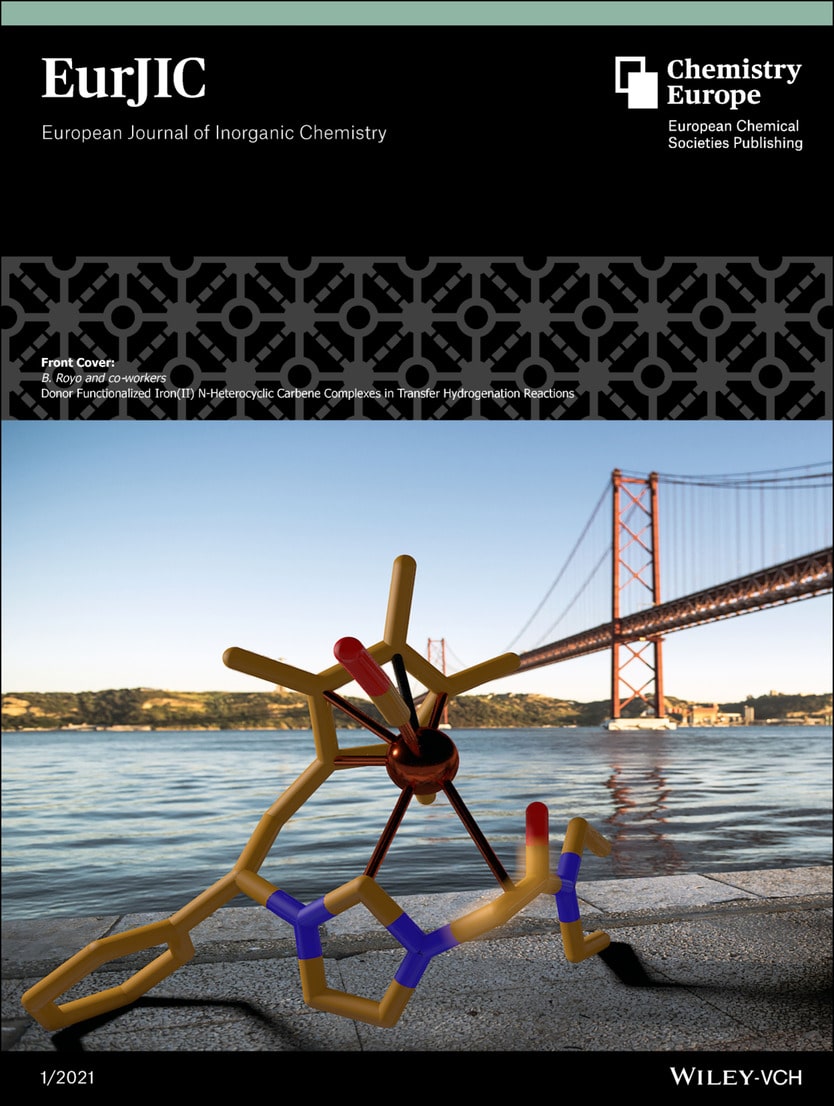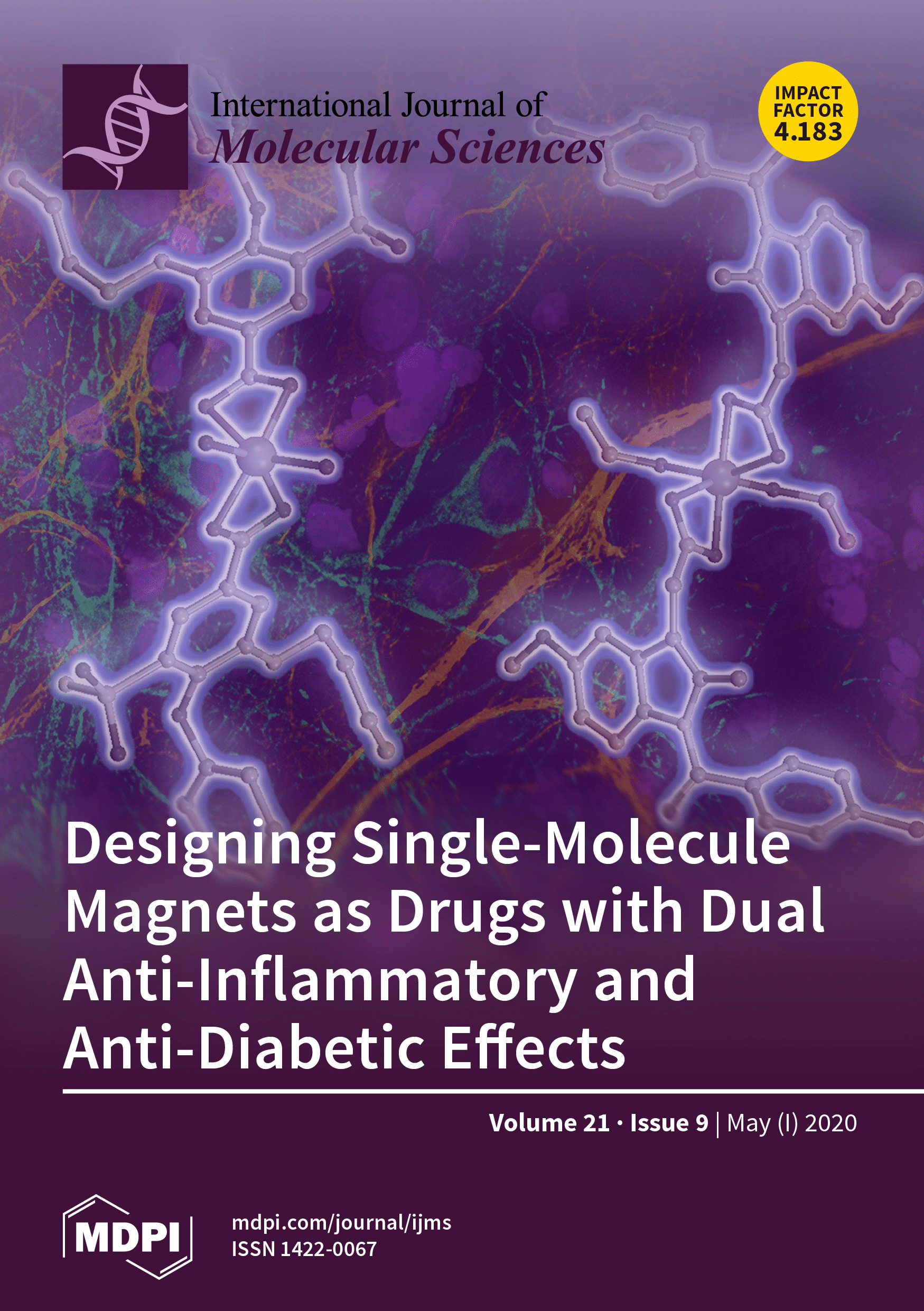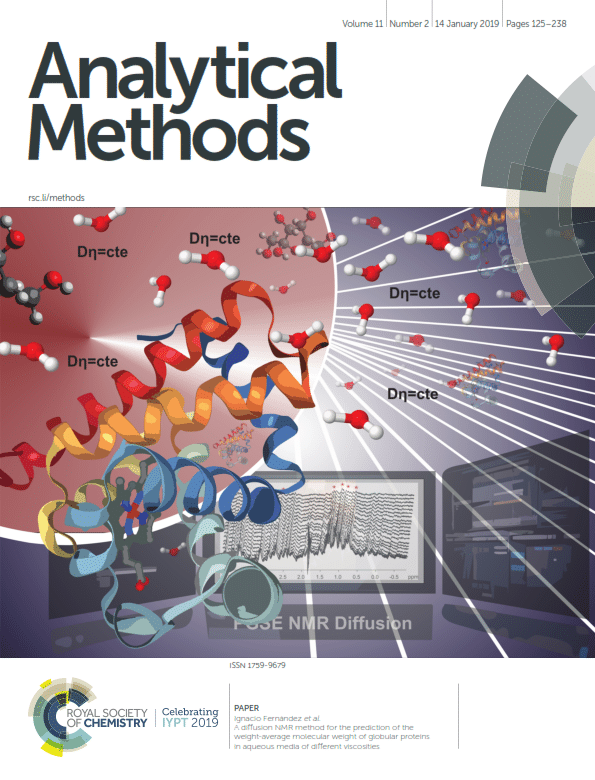Covers

Donor Functionalized Iron(II) N‐Heterocyclic Carbene Complexes in Transfer Hydrogenation Reactions
European Journal of Inorganic Chemistry, Early View, 2021
URL: https://chemistry-europe.onlinelibrary.wiley.com/doi/10.1002/ejic.202001102
DOI: https://doi.org/10.1002/ejic.202001102
Abstract:
Two piano‐stool iron(II) complexes bearing N‐heterocyclic carbene ligands outfitted with acetamide‐ and amine‐pendant arms [Cp*Fe(NHCR)(CO)I] {Cp* = η5‐tetramethylcyclopentadienyl; R = CH2CONEt2 (3), (CH2)2NEt2 (4)}, have been prepared and fully characterized. Their catalytic activity in transfer hydrogenation (TH) of ketones using iPrOH as a hydrogen source and catalytic amounts of base (LiOtBu) has been explored, along with that of previously reported [CpFe(NHCR)(CO)I] {R = nBu (5), (CH2)2OH (6), Et (7), and (CH2)3OH (8)} complexes containing hydroxyl and nonfunctionalized alkyl arms. Complex 3 displayed the highest catalytic activity of the whole series 3–8, reaching a TOF50 value of 533 h–1. NMR monitoring of the stoichiometric reaction of 3 with LiOtBu, allowed the identification of a new species 3' containing a deprotonated amidate moiety, which has been fully characterized by 1H, 13C, and 15N NMR. Finally, a green protocol for the reduction of ketones through TH using glycerol as a hydrogen source, under microwave irradiation in the presence of catalytic amounts of 3 and base has been developed.

Designing Single-Molecule Magnets as Drugs with Dual Anti-Inflammatory and Anti-Diabetic Effects
International Journal of Molecular Sciences, Volume 21, Issue 9, 2020
URL: https://www.mdpi.com/1422-0067/21/9/3146
DOI: https://doi.org/10.3390/ijms21093146
Abstract:
We have designed and synthesized two novel cobalt coordination compounds using bumetanide (bum) and indomethacin (ind) therapeutic agents. The anti-inflammatory effects of cobalt metal complexes with ind and bum were assayed in lipopolysaccharide stimulated RAW 264.7 macrophages by inhibition of nitric oxide production. Firstly, we determined the cytotoxicity and the anti-inflammatory potential of the cobalt compounds and ind and bum ligands in RAW 264.7 cells. Indomethacin-based metal complex was able to inhibit the NO production up to 35% in a concentration-dependent manner without showing cytotoxicity, showing around 6–37 times more effective than indomethacin. Cell cycle analysis showed that the inhibition of NO production was accompanied by a reversion of the differentiation processes in LPS-stimulated RAW 264.7 cells, due to a decreased of cell percentage in G0/G1 phase, with the corresponding increase in the number of cells in S phase. These two materials have mononuclear structures and show slow relaxation of magnetization. Moreover, both compounds show anti-diabetic activity with low in vitro cell toxicities. The formation of metal complexes with bioactive ligands is a new and promising strategy to find new compounds with high and enhanced biochemical properties and promises to be a field of great interest.

A diffusion NMR method for the prediction of the weight-average molecular weight of globular proteins in aqueous media of different viscosities
Analytical Methods, Volume 11, Issue 2, 2019
URL: https://pubs.rsc.org/en/journals/journalissues/ay#!recentarticles&adv
DOI: http://dx.doi.org/10.1039/c8ay01817k
Abstract:
We have introduced for the first time, a non-viscosity dependent universal calibration curve (UCC) for the successful prediction of the weight-average molecular weights of globular proteins in the range of 8.5–66.2 kDa with no dependence on the solvent viscosity. Plots of log(Dη) versus log Mw showed excellent linearity within four different methods (LMS, TRAIn, NNLS and ITAMeD). To demonstrate the applicability of this new UCC curve, we have proposed as a proof of concept the determination of the Mw of myoglobin from an equine heart in deuterated water of four different viscosity values. The corresponding (Dη) values were fitted to the UCC to calculate their corresponding weight-average Mw that was in all the cases centered at 17 321.2 Da, with differences in the mass below 5.7% with respect to the commercial value.

Covalent immobilization of dysprosium-based metal–organic chains on silicon-based polymer brush surfaces
New Journal of Chemistry, Volume 41, Issue 15, 2017
URL: https://pubs.rsc.org/en/content/articlelanding/2017/nj/c7nj00683g#!divAbstract
DOI: https://doi.org/10.1039/C7NJ00683G
Abstract:
We report on a process for immobilizing metal-organic chains constructed of dysprosium and sodium ions based on 5-aminopyridine-2-carboxylic acid{,} onto silicon-based surfaces coated with poly(acrylic acid) (PAA) polymer brushes. Atomic force microscopy (AFM) and fluorescence microscopy were used to study the film morphology before and after the deposition of the 1D metallo-organic polymer. The covalent linkage of the dysprosium complex is also confirmed using X-ray photoelectron spectroscopy (XPS) and energy-dispersive X-ray spectroscopy (SEM-EDS) analysis. Using magnetic force microscopy (MFM) we particularly addressed the magnetic properties of the grafted metal-organic structure. These results suggest a simple and effective method for incorporation of such molecules onto nanometric surfaces.

Peptoid-Ligated Pentadecanuclear Yttrium and Dysprosium Hydroxy Clusters
Chemistry A European Journal, Volume 21, Issue 7, 2015
URL: https://chemistry-europe.onlinelibrary.wiley.com/doi/abs/10.1002/chem.201405569
DOI: https://doi.org/10.1002/chem.201405569
Abstract:
A new family of pentadecanuclear coordination cluster compounds (from now on simply referred to as clusters) [{Ln15(OH)20(PepCO2)10(DBM)10Cl}Cl4] (PepCO2=2‐[{3‐(((tert‐butoxycarbonyl)amino)methyl)benzyl}amino]acetate, DBM=dibenzoylmethanide) with Ln=Y and Dy was obtained by using the cell‐penetrating peptoid (CPPo) monomer PepCO2H and dibenzoylmethane (DBMH) as supporting ligands.
